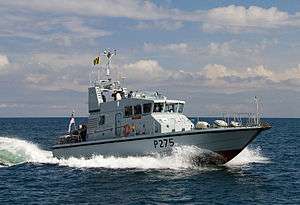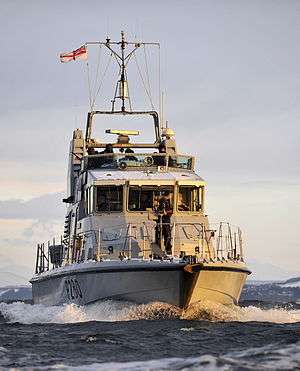Archer-class patrol vessel
The Archer class (or P2000) is a class of patrol and training vessel in service with the United Kingdom's Royal Navy, commonly referred to as a Fast Training Boat.[1] Most are assigned to University Royal Naval Units, although HMS Tracker and HMS Raider are armed and provide maritime force protection to high value shipping in the Firth of Clyde and are most commonly employed as escorts for submarines transiting to Faslane. Pursuer and Dasher are also armed and provide maritime force protection operating with the Gibraltar Squadron.
 HMS Raider, 2009 | |
| Class overview | |
|---|---|
| Name: | Archer class |
| Builders: |
|
| Operators: | Royal Oman Police |
| Succeeded by: | Scimitar class |
| In commission: | 1985 – |
| Active: | 17 |
| General characteristics | |
| Type: | Patrol boat & training vessel |
| Displacement: | 54 tonnes |
| Length: | 20.8 m (68 ft) |
| Beam: | 5.8 m (19 ft) |
| Draught: | 1.8 m (5 ft 11 in) |
| Propulsion: | 2 shafts, Cat C18 ACERT diesels |
| Speed: | |
| Range: | 550 nmi (1,020 km) |
| Complement: |
|
| Sensors and processing systems: | Decca 1216 navigation radar |
| Armament: |
|
Development
Ten vessels were ordered as the P2000 class, based on a design of an Omani coastguard cutter, from Watercraft Marine. They are twin-shaft vessels with moulded glass-reinforced plastic hulls of 54 tonnes displacement.[2][3] After that company went into liquidation, the balance of the order was completed by Vosper Thornycroft.
The Archers were initially used as Royal Navy patrol craft and as training tenders for the Royal Naval Reserve (RNR) and University Royal Naval Units (URNU). Four identical vessels were ordered for the Royal Naval Auxiliary Service (RNXS) as Example-class tenders. When that service was disbanded in 1994, the Examples were transferred to the Royal Navy for similar duties as their Archer-class brethren (under the same names under which they served as "XSVs", all of which begin with the first syllable "Ex"). Until 2005, the four Examples were still painted with a black hull.
In 1998 two additional vessels (Raider and Tracker) of this design were commissioned into the Royal Navy from Ailsa Shipbuilding Company, to replace HMS Loyal Watcher and HMS Loyal Chancellor as URNU training vessels for the two newest URNUs, serving Cambridge and Oxford Universities respectively (Raider was later transferred to Bristol URNU whilst Trumpeter became the ship of Cambridge URNU). This brought the total of Archer class vessels in the Royal Navy to sixteen, of which fourteen form the Coastal Forces Squadron Squadron (formerly the 1st Patrol Boat Squadron), each one attached to an URNU (one per unit) under the command of a Lieutenant.[4] The remaining two vessels (Pursuer and Dasher), having formed the Cyprus Squadron from 2003 to 2010, and URNU vessels before that,[N 2] returned to the UK in April 2010 to form the Faslane Patrol Boat Squadron, performing security duties within HMNB Clyde.
In 2012 Dasher and Pursuer were replaced by Raider and Tracker - these can be identified by a number of pintle-mounted L7 7.62 mm GPMG machine guns and armour plating. Ranger and Trumpeter were also formerly allocated to the Gibraltar Squadron for guard ship and search and rescue duties, but were replaced by the dedicated Scimitar class. These two ships were also used during the Thames River Pageant, escorting the Royal Barge during the Queens Diamond Jubilee. Unlike the remainder of the class, both these ships remain capable of being mounted with a 20 mm cannon on the fo'c'sle.
The NATO designation of a P2000 is "PBR", denoting a "Patrol Boat - Riverine and Harbours".
Vessels in the class

| Royal Oman Police | |||||
|---|---|---|---|---|---|
| Name | Pennant number | Builder | Commissioned | Attached to | Status |
| Dheeb Al Bahari | Watercraft Marine, Shoreham-by-Sea | 1985 | Police Coastguard Command | In active service | |
| Royal Navy | |||||
| Name | Pennant number | Builder | Commissioned | Attached to | Status |
| Archer | P264 | Watercraft Marine | 1985 | Edinburgh URNU | In active service |
| Biter | P270 | Watercraft Marine | 1986 | Manchester URNU | In active service |
| Smiter | P272 | Watercraft Marine | 1988 | Oxford URNU | In active service |
| Pursuer | P273 | Vosper Thornycroft, Woolston | 1988 | Gibraltar Squadron[5] | In active service |
| Blazer | P279 | Vosper Thornycroft | 1988 | Southampton URNU | In active service |
| Dasher | P280 | Vosper Thornycroft | 1988 | Gibraltar Squadron[6] | In active service |
| Puncher | P291 | Vosper Thornycroft | 1988 | London URNU | In active service |
| Charger | P292 | Vosper Thornycroft | 1988 | Liverpool URNU | In active service |
| Ranger | P293 | Vosper Thornycroft | 1988 | Sussex URNU | In active service |
| Trumpeter | P294 | Vosper Thornycroft | 1988 | Cambridge URNU | In active service |
| Example (ex-XSV Example) | P165 (ex-A153) | Watercraft Marine | 1985 | Northumbrian URNU | In active service |
| Explorer (ex-XSV Explorer) | P164 (ex-A154) | Watercraft Marine | 1986 | Yorkshire URNU | In active service |
| Express (ex-XSV Express) | P163 (ex-A163) | Vosper Thornycroft | 1988 | Wales URNU | In active service |
| Exploit (ex-XSV Exploit) | P167 (ex-A167) | Vosper Thornycroft | 1988 | Birmingham URNU | In active service |
| Tracker | P274 | Ailsa Shipbuilding Company, Troon | 1998 | Faslane Patrol Boat Squadron | In active service |
| Raider | P275 | Ailsa Shipbuilding Company | 1998 | Faslane Patrol Boat Squadron | In active service |
See also
- Harbour Defence Motor Launch - World War II equivalent
- CB90 class fast assault craft
- Patrol Craft Fast - the "Swift Boats"
Notes
- 5 ship's company, 1 training officer, 12 URNU students.
- Pursuer was allocated to Sussex URNU, Dasher to Bristol URNU. They were replaced by Ranger and Trumpeter respectively in 2004.
References
- "Archer Class Patrol and Training Vessel". Ships of the Royal Navy. Archived from the original on 29 March 2010. Retrieved 25 March 2010.
An interesting quirk of the Archer class is that although the regular crew have their own cabins, the Midshipmen sleep in the gun-room. Traditionally this is where midshipmen have always been berthed but in the Archer class it is literally true as they sleep in the magazine of the Archer class. Since such trips only occur in times of peace, the gun which an Archer class vessel is capable of carrying is not fitted and so there is no other use for the magazine.
- "Patrol Boats – Archer class". Royal Navy. Retrieved 4 June 2018.
- "Archer Class P2000 (URNU)". Armed Forces.net. Retrieved 9 March 2019.
- "Coastal Forces Squadron" (PDF). whatdotheyknow.com. Whatdotheyknow.com. 6 July 2020. Retrieved 16 July 2020.
I can confirm that Ministerial approval for the change in name from 1st Patrol Boat Squadron to Coastal Forces Squadron was given on 21 May 2020.
- https://www.royalnavy.mod.uk/news-and-latest-activity/news/2020/june/22/200622-hms-pursuer-and-dasher-prepare-for-rock-mission
- https://www.royalnavy.mod.uk/news-and-latest-activity/news/2020/june/22/200622-hms-pursuer-and-dasher-prepare-for-rock-mission
Bibliography
- Beaver, Paul (1996). Britain's Modern Royal Navy. Patrick Stephens Ltd. ISBN 1-85260-442-5.
- Flack, Jeremy (1996). Today's Royal Navy in Colour. Greenwich Editions. ISBN 0-86288-089-0.
External links
| Wikimedia Commons has media related to Archer class patrol vessel. |
- "Patrol Boats - Archer class". Royal Navy.